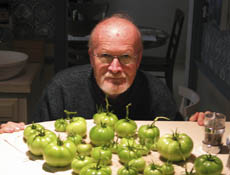 |
|
|
I seek the ultimate pot, the transcendent vessel. The vessel has been a source of forms, ideas and meaning for me since 1960 when I began casting bronze vessels by the lost wax process. My interest has ranged from traditional container forms with textured and patterned surfaces to pure geometric sculptural pieces. I attempt small essays in form. A bowl is an architectural statement; its terms are mass and void, plane and volume. It can have open, welcoming shapes or closed, protective ones. I think about the transition from inside to outside and about the shaping and enclosure of space itself. A good bowl is grounded in function, and our response to it is based on our familiarity with its everyday, traditional forms. It is an idiom we all understand from shared experience. I share this interest in the sculptured vessel with other artists, and other cultures, that go back to the Bronze Age, most notably to the ritual vessels of ancient China. Like the Chinese bronzes, my pots are small monuments related to an architecture of the spirit. As with most temples and religious structures, the organizing principle of my pots is symmetry. I am drawn to solutions that are balanced and axial with a stable central core around which shapes can cluster, spiral or build. The vessel’s symmetry is an analog for our individual experience of being centered, physically and spiritually, in the world. I grew up in California, at a time when various movements and influences were making a rich cultural brew, and I drew from all of them. To begin with there was the Arts and Crafts tradition, long established, which celebrated functional objects, beautifully hand crafted, made to create a tasteful environment for an enlightened lifestyle. In the 50’s that was overlaid by new currents of artistic ideas. One was Abstract-Expressionism, (with roots in the Bay Area as well as in New York,) with its aesthetic of gesture and spontaneity along with hints of shamanism and other primitive urges. A counterpoint to that was the functionalist aesthetic of the Bauhaus and the International Style, the pure forms of constructivism, the sculpture of Brancusi, Arp and Noguchi that led to Minimalism and primary forms of the 60’s. My bowls reflect all these various influences. Over a long period of time I have worked in different modes, at times rationalist, at times expressionist, but always with constant belief in the strength and universality of the vessel itself. |
